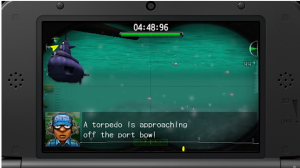Nintendo just made a mess.
That wall over there, it was clean yesterday. Today, however? Well, that crazy scientist we call Nintendo just walked into the room and threw two very different free-to-play 3DS game designs at the wall … and we’re all invited to see what sticks.
Shareware 2014?
That first petri dish that hit the wall is a multiplayer submarine game, Steel Divers: Sub Wars. Players get a rack of customizable submarines, which they can use to grind through a single-player campaign or compete in either local or online multiplayer. Online multiplayer is a crucial mode, as this is where players earn experience to level up and unlock more submarines. It is also where players can discover and capture special crew members, who add certain abilities and stats to the subs.
Putting on my imaginary Nintendo CEO hat, my first assumption would be that Steel Divers: Sub Wars would utilize a microtransaction design for its economy. Maybe even something similar to World of Tanks, where getting to really cool submarines and equipment require either a significant time investment or cash.
But like the majority of people that try to second-guess Nintendo, I am very much wrong. Nintendo is going with a more modern shareware approach, with a free and premium (paid) version.
The free version provides players with two submarines, two single-player missions, and both multiplayer modes (local and online). Paying for the premium version unlocks the rest of the game, including the capability to earn all submarines and collectibles. The angle here is that premium and free players are not separated online. Free players roaming the online multiplayer games are at the mercy of the potentially buffer arsenal of a premium player. Although Nintendo assured me that the free submarines, in the right hands, should be able to hang against premium hardware, free players are still going to be missing a significant portion of the upgrades and the strategies they provide in the game. It’s try-before-you-buy, except you’re trying among players with potentially deadlier toys.
Dog-haggling simulator
The other experiment hanging on the wall is an unique idea called Rusty’s Real Deal Baseball. Players are visiting a baseball camp that a dog named Rusty runs. The camp is divided into a handful of episodes, with each episode containing a number of baseball-inspired activities. Doing well at one of these minigames, which involves challenges like smacking home run hits in a batting cage or catching line drives, earns special items. As the player progresses, more minigames become available for purchase via a micro-transaction system. So, how much does the player have to pay per game? Well, that’s where things get interesting.
Rusty is an amazing dog who, on top of running a baseball camp, also owns and operates the in-game baseball store where all transactions take place. The real-world price for a microtransaction, however, is not set in stone: You can persuade Rusty to lower his prices through haggling. Every product has an optimal strategy that players can use to work Rusty down to his absolutely lowest price. You can also give the dog items that you earn from playing the minigames at opportune times to help sweeten negotiations. So, how much will it cost to unlock everything in Rusty’s Real Deal Baseball? It’s kind of up to you.
Nintendo goes mobile! Oh, wait. You mean that other mobile?
It’s fun to play armchair executive and second-guess what Nintendo should, could, or would do — but the company is being predictably unpredictable. Plenty of people are talking about how it could reverse their current loss projections with ideas like licensing their characters out, getting into mobile gaming, purchasing more development houses, and perhaps merging with other companies. Nintendo has plenty of time for any or all of those scenarios to come true, but when it comes to the mobile gaming prediction, it looks like we were only half right. Nintendo is definitely experimenting with free-to-play on a mobile platform.
It’s just that some of us assumed Nintendo would be throwing these experiments at a smartphone-shaped wall, not so much one that looks like a 3DS.
VentureBeat's mission is to be a digital town square for technical decision-makers to gain knowledge about transformative enterprise technology and transact. Learn More


